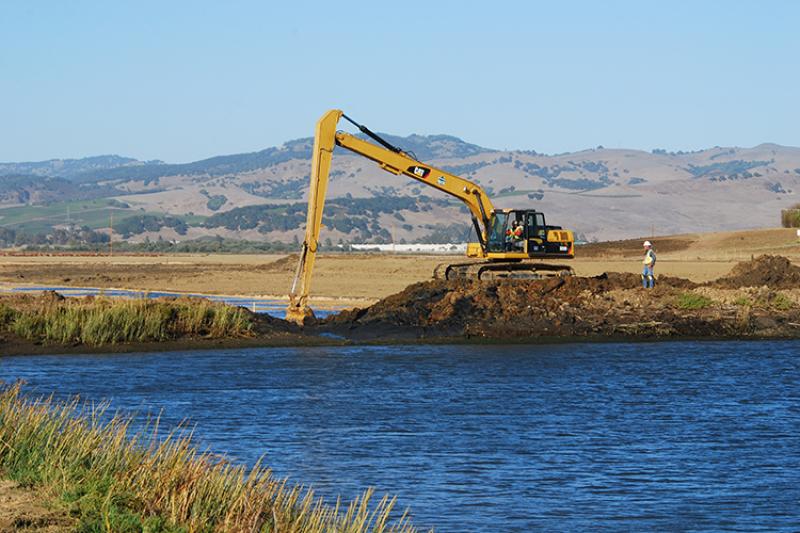NOAA is recommending more than $265 million in funding for 38 transformational habitat restoration and coastal resilience projects this year, as well as an additional $20.4 million in funding in future years. These projects are supported by the Biden-Harris Administration’s Bipartisan Infrastructure Law with funding leveraged from the Inflation Reduction Act. This is a historic investment in strengthening the climate resilience of our nation’s coastal ecosystems and communities.
The Bipartisan Infrastructure Law provides an extraordinary opportunity for NOAA to continue making an impact for fisheries, protected resources, and coastal communities. These projects span a broad range of habitats and restoration techniques. They will reconnect rivers to their historic floodplains, outplant corals to rebuild reefs, build living shorelines that will protect coasts from erosion and sea level rise, and more.
View the full list of projects recommended for funding
Transformational Habitat Restoration and Coastal Resilience
These projects will have a transformative impact across the country, through:
- Capstone projects that build on decades of work in priority watersheds
- Innovative projects that implement cutting-edge restoration techniques
- Groundbreaking efforts that restore habitat in urban ecosystems to benefit underserved communities
They will help protect coastal communities and ecosystems from the impacts of climate change, and make significant strides in the recovery of threatened and endangered species.
Building on Decades of Work
Many projects are the culmination of decades of financial and technical support from NOAA and partners. In Massachusetts, construction will begin on the Herring River Restoration Project, the largest salt marsh restoration effort in the northeast United States. NOAA has been engaged in this work for nearly two decades, providing more than $5 million of the approximately $8 million total project costs to date. In North Carolina, partners will restore close to 120 acres of oyster habitat in Pamlico Sound, leading to the completion of the 500-acre goal of the Jean Preston Memorial Oyster Sanctuary.
Implementing Innovative Techniques
Some projects will use innovative methods to restore habitat, and will promote the sharing of best practices and new approaches to build capacity for restoration work. Six projects spanning Hawaii, Florida, Puerto Rico, and the U.S. Virgin Islands will help transform how coral restoration is conducted in these regions. Expanding the capacity to grow and plant corals will help rebuild reefs and make progress in the recovery of threatened species like elkhorn and staghorn corals. Sharing technologies and best practices used in areas where NOAA and other practitioners are at the forefront of coral restoration will help scale up coral restoration in other regions. Restoring habitat at a watershed scale, across multiple habitats, will reduce land-based pollution and support resilient reefs that can better survive future climate conditions.
Benefiting Urban Ecosystems and Underserved Communities
Several projects will restore habitats in urban areas and provide benefits to nearby historically underserved communities. Groundworks Jacksonville will restore habitat along two urban waterways in Jacksonville, Florida. Restoring these streams will significantly reduce flooding in nearby underserved neighborhoods, protecting homes and other structures. The projects will also improve water quality and help connect the local community to green space and recreation along the water.
Building Resilience to Climate Change
Many projects will help protect coastal ecosystems and communities from the effects of climate change, such as increased flooding, rising sea levels, and larger, less predictable storms. A suite of restoration activities in San Mateo County, California, will address chronic flooding that has occurred for years. This will help to protect homes and infrastructure in communities like the Town of Pescadero. An effort in South Carolina will significantly scale up the use of living shorelines and other nature-based infrastructure along the state’s entire coastline. It will include a partnership with the Gullah Geechee Cultural Heritage Commission to engage community members in living shoreline projects. In Alabama and Florida, a large-scale effort in the Perdido watershed will help increase protection against flooding and storms. It will include construction of several living shorelines and engaging communities in developing future nature-based infrastructure projects.
Supporting Recovery of Endangered Species
Degraded habitat is one of the largest obstacles to recovering threatened and endangered species. Many projects will make significant progress on efforts to recover these species by restoring the habitats they depend on for food, protection, spawning, and rearing. Two landscape-scale, complementary efforts in Washington’s Puget Sound will provide substantial benefits to threatened Puget Sound Chinook and steelhead, making significant progress on addressing the habitat-related factors needed for their recovery. The projects will also support endangered Southern Resident killer whales, a NOAA Species in the Spotlight, by benefiting their prey. This work will build on more than two decades of past NOAA-supported restoration work in these watersheds.
Habitat Restoration and NOAA
NOAA invests in habitat restoration across the country to support our nation’s fisheries and protected resources, while also strengthening the resilience of coastal communities and ecosystems. Efforts like restoring coastal wetlands and removing outdated dams can improve coastal resilience—helping communities recover from and adapt to the impacts of extreme weather and climate change.
NOAA’s Office of Habitat Conservation has a long history conducting habitat restoration efforts, including fish passage, with large-scale competitive funding opportunities and expert technical assistance. Through our Community-based Restoration Program, we have partnered with more than 2,600 organizations to take on more than 2,200 projects since 1996. These efforts have restored more than 94,000 acres of habitat and opened up more than 4,400 miles of streams and rivers to fish migration.



